Part 4: Dances of the Balkans
12 Dances of Greece, Albania and Kosovo
1. The Countries
1.1. Greece (Ελλάδα)
I think everyone knows that Greece is viewed as the cradle of Western (European) Culture. Many dominant themes in western Philosophy, Political Structures, Science, and the Arts find their origins in this country. So, I’ll spare you the long lesson on the ancient Greeks and focus on relatively recent events.
Greece is in the southern part of the Balkans. It shares land borders with Albania, North Macedonia, Bulgaria, and Turkey. In addition to the mainland peninsula, it is the country that controls several islands in the Adriatic and Aegean Seas. These islands have dance and music cultures different from those on the mainland.
Until the middle of the 19th century, Greece was part of the Ottoman Empire, so one finds important Turkish cultural influences. Don’t get a Greek or a Turk on the topic of whether the specialized coffee of the region should be called “Greek coffee” or “Turkish coffee”! But Greece largely retained the Orthodox Christian religion that emerged from the Eastern (or Byzantine) Roman Empire that preceded the Ottomans. The Greeks were recognized as the merchant class of the Ottoman Empire, and prior to World War 1, they had significant communities in what is now Turkey and Bulgaria.
After a war of independence from the Ottomans and after being on different sides during WWI, the Greek populations of Turkey and the Turkish populations of Greece were forcibly exchanged. This resulted in several musical and dance traditions in Greece that look more Turkish than Greek. The people of Pontos, who left Turkey for Greece, brought the dance styles of the Black Sea region of Turkey with them when they were relocated. Similarly, Greek populations who lived in Bulgaria were forcibly moved into what is Modern Greece. Greece has had its fair share of recent political upheavals. It has been ruled as a fascist dictatorship, by a Junta of generals, and as parliamentary democracy. There are on-going tensions with Turkey, especially over the island of Cyprus, and until very recently, with Slavic North Macedonia.
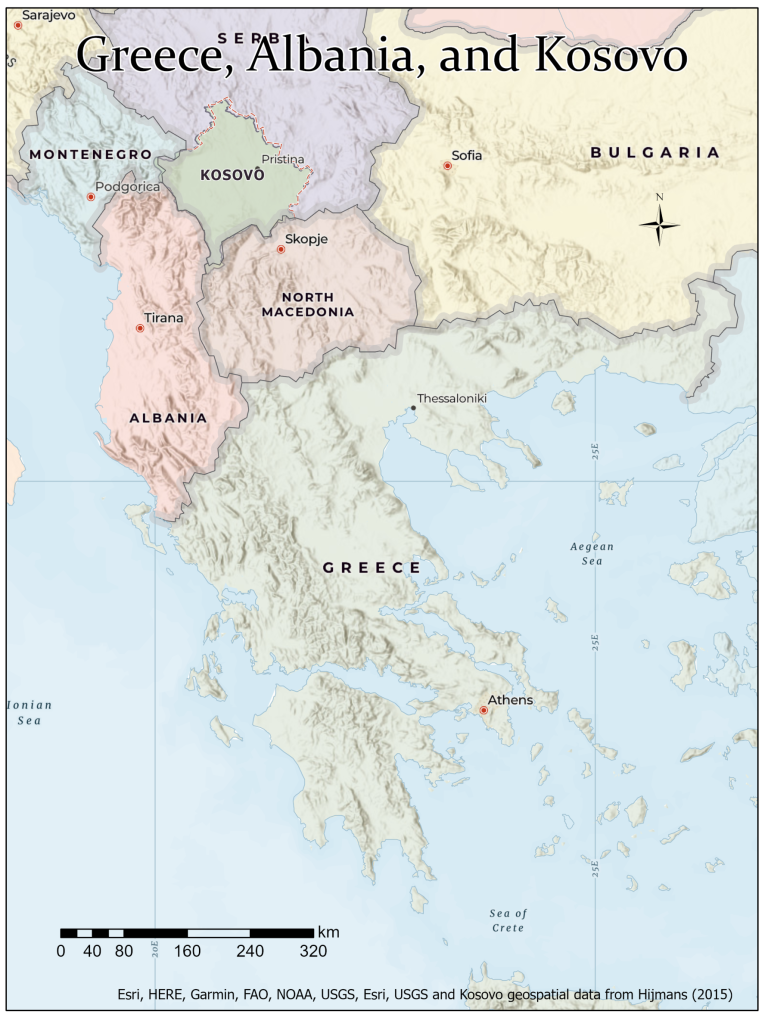
1.2. Albania (Shqipëria) and Kosovo
Until relatively recently, Albania was a total mystery to most westerners. This happened because, like North Korea now, Enver Hoxha’s Marxist dictatorship tightly controlled Albania, closing the country completely to the West.
The Albanians speak a very different language than all their neighbors, and the region is highly mountainous and isolated. But in terms of dance culture and costume at least, Albanians have a great deal in common with the Greeks in the nearby province of Epirus. Unlike the Greeks, many Albanians converted to Islam under the Ottomans. However, under the Marxist regime in the 20th century, religion was highly suppressed. If you look at a map of Albania, you’ll see that it’s actually very close to southern Italy. There are significant communities of Albanians living in Italy, who fled the communist regime in their home country, and those communities continue to perform the dances and songs of their homeland.
In the last 30 years or so, Albania has been in conflict with many of its neighbors. There have been riots and battles between Slavs and Albanians in North Macedonia. But the most famous conflict has been over the new country of Kosovo. Traditionally Kosovo was part of Serbia, but today it is majority Albanian. At the end of the 20th century Serbia and the local Albanians fought a brutal war, which included genocide and terrible human rights abuses. The war, after intervention from the USA, UN, and EU, resulted a highly divided independent state called Kosovo. Still today, different ethnic populations live within the same cities, but do not interact with each other at all. All groups fiercely cling to their ethnic identities. The Albanians of Kosovo have a strong music and dance tradition that closely mirrors that of their compatriots who live in Albania itself. The Serbians in Kosovo have a similar relationship with the dances of Southern Serbia. In addition to these two communities, one also finds significant populations of Roma and other minority ethnicities, who all have their own music and dance.
Albania is roughly divided into two major cultural zones. In the south, there are the Tosks, whose dance and music are closely related to that of their neighbors in Greek Epirus. In the north, there are the Gheg, whose music and dance show the influence of their neighbors in Kosovo, Macedonia and South Serbia.
2. Folk Costumes
The costumes of Albania and Northwestern Greece (in particular Epirus) are very similar. The women wear long ankle length dresses with red embroidered vests. An important distinction between the Albanian and Greek women’s costumes are in the headdresses of the women. Albanian women wear headdresses that cover their hair. The men from both countries wear short puffy kilts called fusteanellë/foustanélla (φουστανέλλα), and white leggings. One striking part of the costume of both Greek and Albanian costumes are the shoes (Tsarouhi/τσαρούχι) with giant pompoms on the toes.
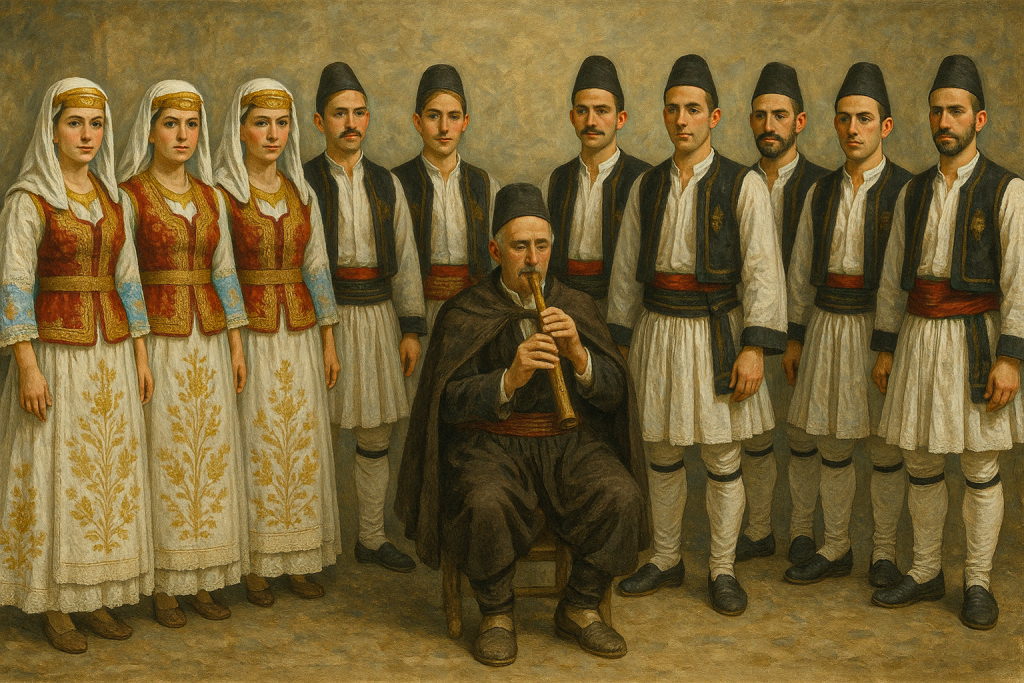
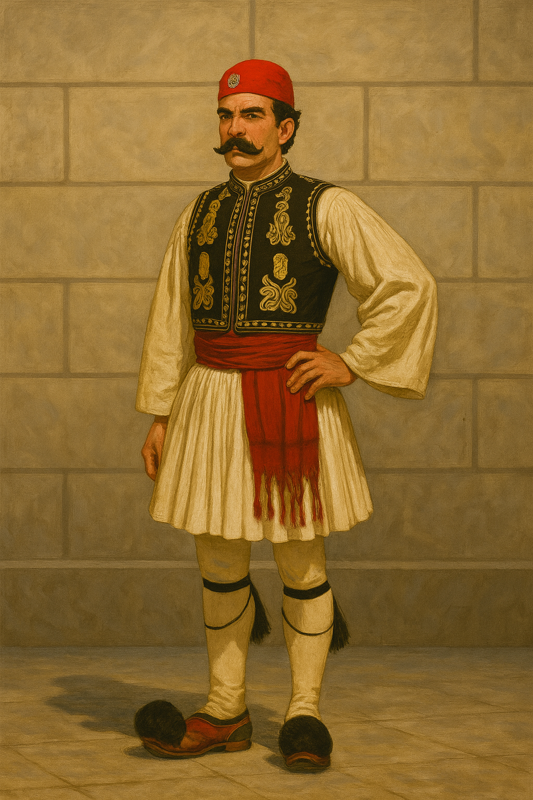
There are other regional Greek costumes. Two that are particularly notable are the men’s costumes from Pontos (now part of Turkey), which are nearly identical to the men’s costumes from the Black Sea region of Turkey, and the men’s costumes from Crete, which have a striking blue color.
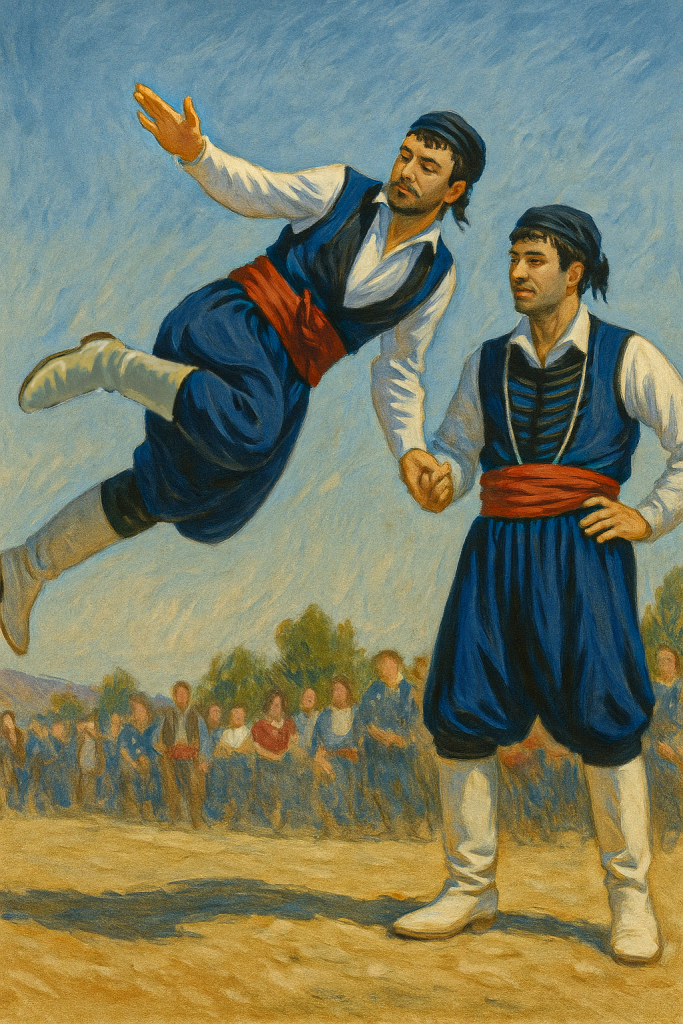
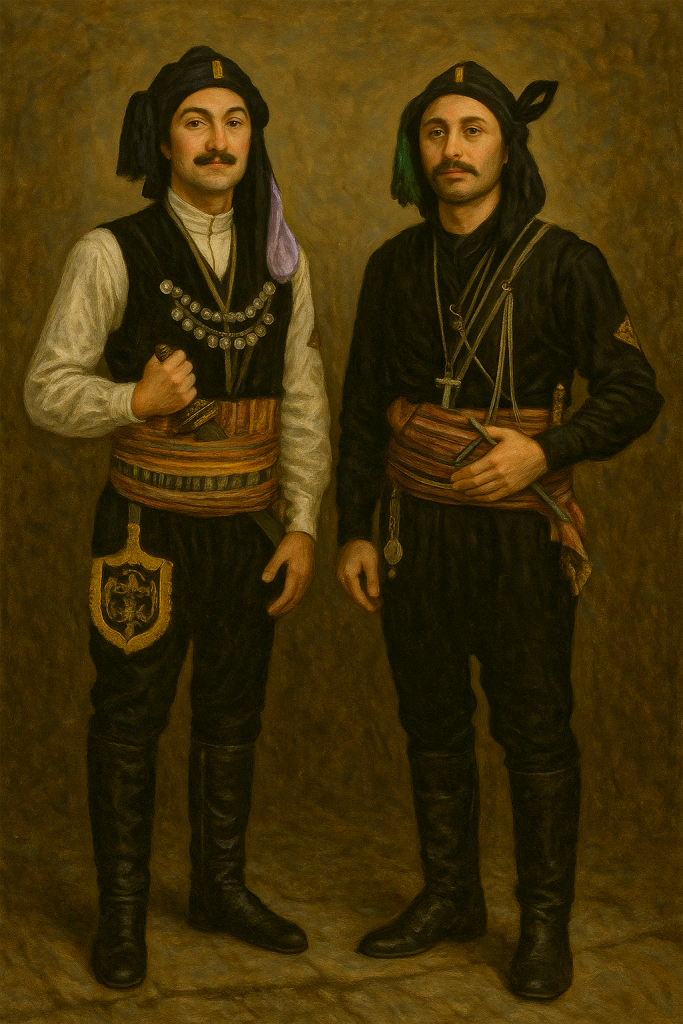
3. Music
3.1. Greece
The most iconic instruments in Greek music are the bouzouki (μπουζούκι) and lauto (λαούτο); these instruments give Greek music its distinctive sound. Other common instruments are the tsampouna bagpipe (τσαμπούνα), zourna (ζουρνας), clarinet (κλαρινέτο), violin (βιολί), lyra(λύρα), and oúti/oud (ούτι).

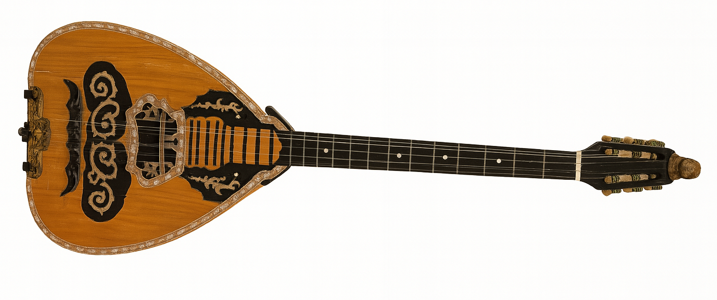
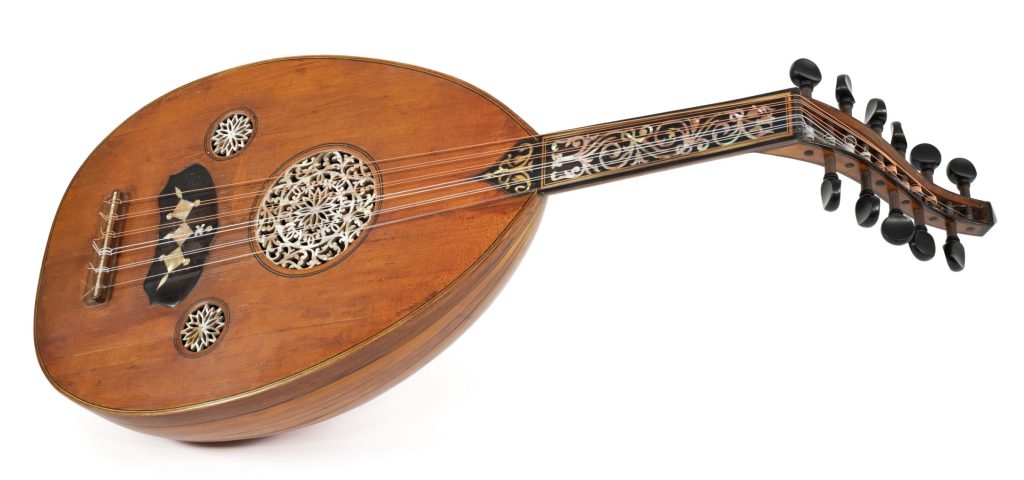

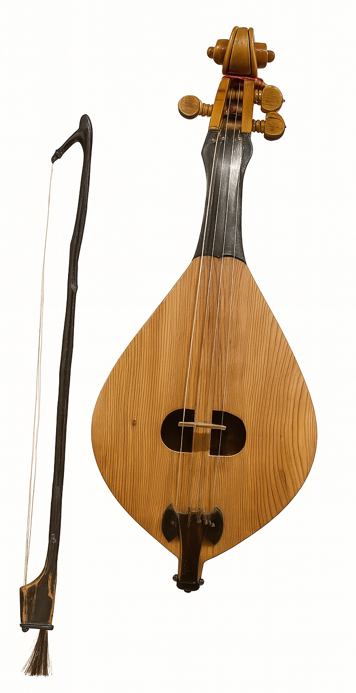
- Typical Greek Taverna Music: https://youtu.be/xtZkzIR-zpg
- Taverna Music: https://youtu.be/gUeMZez8GzU?si=QzUCx6r7HnbcMh_o
- Island/Cretan music: https://youtu.be/KiwvAjPUP6U
- Cretan music: https://youtu.be/Dri3DubX5KE?si=1DYg5WhU9C2gauwk
- Music from Epirus: https://youtu.be/Dv-RdFPQwEU?si=uC-SffLt_V66ya_f
- Pontic Music: https://youtu.be/WwyvJfuD-SM?si=lKL4y9l8Hgs_TiTb
- Pontic Music: https://youtu.be/jJYaIKn78GY?si=uULeN1dxwyD-Il5C
3.2. Albania and Kosovo
By far the most prominent instrument in Albanian music is the clarinet. In Albanian Kosovo, the singing tradition in Albania is strong. Very traditional songs are polyphonic (meaning multiple voices). Polyphonic songs involve several different drone singers and people singing simple melodies at the same time,[1] Popular Albanian music retains many of these traditional elements, but often adds in electronification into the music. Other traditional instruments include the Daire, the Sharki and the Zumare.
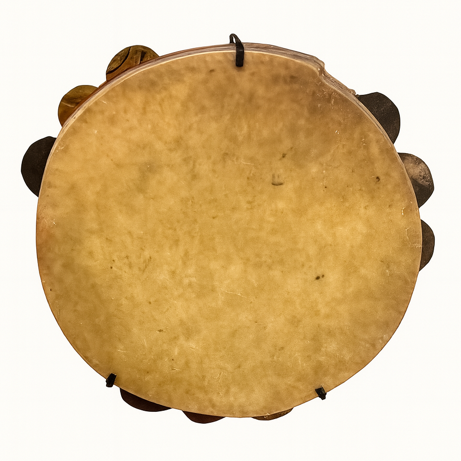

Figure 12.12: Zumare, Lezhe Albania
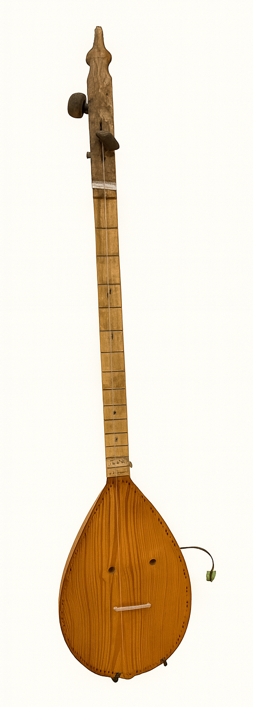
- Albanian Clarinet playing a Kaba followed by a Valle: https://youtu.be/AiqDiIyEtI4
- Polyphony: https://youtu.be/gtFqA9hYvcw
- Irini Qirjako: https://youtu.be/oc8I7gv3NWI
- Gezim Kaso: https://youtu.be/-7Cr570SEco
- Rexhip Sinaj: https://youtu.be/yUNAVSZ9Bhk
4. Dance
4.1. Albania
If you go a wedding in Albania, you will almost certainly do one dance for most of the evening. This is the valle (which means “dance”), also known as Pogonishte. It is a simple two bar figure that fits most Albanian popular recordings. The dance is identical to the dance done in nearby Greek Epirus called the Pogonisios or Sta Dhio. A dance that is done to impress visitors is the Valle Devolliçe where the dancers do large leaps and lifts. The lead dancer in Valle Devolliçe does a move where they fall backwards onto the next few dancers who hold them up.
- Acrobatic Valle Nga Korça: https://youtu.be/MgNVU3nFlyY
- Albanian Pogonishte/Valle: https://youtu.be/8u_xTUpcI_M
- Valle Devolliçe: https://youtu.be/H_SQaDwbdBY?si=XU7QYNLXNFLjXLHQ
4.2. Kosovo
In many Albanian villages, the men do a complex cycle of dances called Kallaqoja. What’s particularly interesting about this dance cycle is several parts of it are rubato, meaning that there is no fixed meter. Instead, the musicians (usually a zurna player and a drummer), hit the beats based on what the lead dancer is doing. This style of dance is noteworthy for its slow pauses and balance. Leading the dance is a sign of leadership in the village.
Women’s dances from the region are typically associated with weddings. Since women are expected to leave their home village and move to the village of their husband, weddings are considered sad times for the bride and her family as she will be very unlikely to see them again soon and she will be moving in with a bunch of strangers. So many of the women’s dances are rituals of mourning for the soon to be departed bride. One such beautiful dance is Moj Hatixhe. Which has the following translated lyrics (from Steve Kotansky):
My Hatixhe with the red scarf
Your mother will color your hair with henna
You hair will be red and charmed by the spirits
Does it pain you to leave your father and mother
Father, mother, and two brothers
I go to my husband and old age will come to me.
I go to my husband and old age will follow
And the children will hang by my aprons
The children will hang by my aprons
And the workers will ask for food.
The workers will ask for food.
How I long to be a bride again.
- Kallaqoja: https://youtu.be/bRYy1Kzaq_Y?si=cPe3ekaNkBHLk-nx
- Moj Hatixhe: https://youtu.be/JOU88gUqUrs?si=FgrMbsBXrLZHgnT2
4.3. Greece
There are many iconic dances done both nationally and regionally in Greece. Here is a selection: The Syrtos/Συρτός (2/4) and the Kalamatianos/Καλαματιανός (7/8) are essentially the same 4 bar dance. You find the basic dance and variations throughout the whole country. The Tsamikos/Τσάμικος is the dance meant to imitate the Cham people of southern Albania. The Zonaradikos/Ζωναράδικος is largely limited to the far northeast of the country in Thrace. It is nearly identical in music and structure to the Pravo Trakijsko of the Bulgarians right across the border to the north. The Serra/Σέρρα is a fast-moving men’s dance typical of the dances of the Pontic people who were forcibly moved from Pontos in Turkey. The dance is characterized by fast, quick, almost jerky movements and extremely fast small steps. Hasapikos/Χασάπικος is a “Butcher’s dance” it comes in both slow versions and fast versions (sometimes called Hasaposervikos/χασαποσέρβικο). When you combine the fast and slow hasapikos together you get a Syrtaki/Συρτάκι. The most famous syrtaki on film was the dance on the beach done by the lead characters in the movie Zorba the Greek.
There are some dances that are limited to just the islands. Pentozali/Πεντοζάλης is a fast but largely stationary dance characterized by fast foot movements from the Islands. Another is the Island Syrtos (called variously Syrtos Haniotikos, Syrtos Rodou, or Kritikos Syrtos), a version of which is danced to the famous tune Misirlou.
One of the oldest and most interesting dances done by the Greeks is the Zeibekikos/Ζεϊμπέκικο. A version of this is also done by the Turks (who call it Zeybek). It may well have its origins in ancient shamanistic rituals. During the dance, the community gathers in a circle, kneels, and claps. A solitary dancer (historically only men, but now women do it too) comes into the center and assumes the role of an eagle, flying over the valleys and hunting below. In ancient times the dancers may have been drugged and visualized themselves in the air. In modern times, the dancers are often impaired by alcohol, and it’s not clear that they think they are turning themselves into eagles, but they are still expected to demonstrate control and elegance.
- Syrtos/Kalamatianos: https://youtu.be/mAz91lvI-JQ
- Zonaradikos (Thrace): https://youtu.be/QmxyCZrKxuY
- Tsamikos From the Epirus: https://youtu.be/OWl3ELNzkl8
- Hasapikos (Syrtaki): https://youtu.be/ay8fUVpLyEk
- Serra: Pontic Dance from the Black Sea: https://youtu.be/Fiz49JUsLFU
- Pentozali Cretan Dance (notice the very militaristic dance costumes): https://youtu.be/b6e7xmnWlEg
- Syrtos Haniotikos (Kritikos): https://youtu.be/kx7kmDZta1E
- Zeibekikos: https://youtu.be/GTFjKnzLeSg
- Greek Pogonisios/Sta Dhio: https://youtu.be/u19ikWbFUiM
Further Reading
- Cowan (1990), Crosfield (1948), Friedberg (2005), Hunt (1996), Karras (n.d.), Pappas (2011), Petrides and Elfleida (1961), Shetuni (2011), Stratou (1966). Full citations can be found in the references at the end of the book.
- https://www.albanian-folklore.com/dances/
Some Suggested Dances for Teaching
Albania
- Valle: http://folkdancemusings.blogspot.com/2014/02/valle-albania.html
- Koritsa: http://folkdancemusings.blogspot.com/2016/02/koritsa-albania.html
- Çobankat: http://folkdancemusings.blogspot.com/2014/05/cobankat-albania.html
- Vallja E Dardhës: https://folkdancemusings.blogspot.com/2018/10/valle-e-dardhes-albania.html
Albanian Kosovo
- Kcim: https://folkdancemusings.blogspot.com/2021/06/kcim-shota-kosovo.html
- Vallja Hasan Aga: https://folkdancemusings.blogspot.com/2022/07/vallja-hasan-aga-albaniakosovo.html
Greece
- Ais Girogis: http://folkdancemusings.blogspot.com/2014/05/ais-giorgis-greece.html
- Sta Dyo: http://folkdancemusings.blogspot.com/2008/02/sta-dyo-greece.html
- Hasaposervikos: http://folkdancemusings.blogspot.com/2014/12/hasaposervikos-greece.html
- Hasapikos: http://folkdancemusings.blogspot.com/2015/04/hasapikos-greece.html
- Kalamatianos: http://folkdancemusings.blogspot.com/2014/04/kalamatianos-greece.html
- Syrtos: http://folkdancemusings.blogspot.com/2014/04/syrtos-greece.html
- Tsamikos: http://folkdancemusings.blogspot.com/2014/07/tsamikos-12-count-greece.html
- Sampson: http://folkdancemusings.blogspot.com/2011/09/sampson-pontos.html
- Chala Chala: http://folkdancemusings.blogspot.com/2008/03/chala-chala-pontic-greek.html
- Chiotikos: http://folkdancemusings.blogspot.com/2015/11/chiotikos-greece.html
- Island Syrtos: http://folkdancemusings.blogspot.com/2014/04/island-syrtos-kritikos-syrtos-syrtos.html
- Zonaradikos: http://folkdancemusings.blogspot.com/2008/03/zonaradikos-stano-greece.html
Discussion Question
Discussion Question 1
Dances done by Albanian communities in Prizren, Kosovo are traditionally done in gender segregated lines, with the men in the “lead” line and the women following behind. By contrast the almost identical dances done by members of the Roma communities in Gnjilane, Kosovo — only 25 miles away from Prizren — are done in mixed-gendered lines where the sexes are allowed to touch each other. Reflect on the reasons why there might by such a significant difference between the two communities? In the context of American folk-dance class is it ok to do the Prizren dance in mixed lines?
Media Attributions
- Figure 12.1: Map of Greece, Albania, and Kosovo © John W. W. Powell. Additional geospatial data cited in map. Used here with permission.
- Figure 12.2: Albanian Costumes © Saman Meihami, with the assistance of ChatGPT. Used with permission
- Figure 12.3: Greek Men’s Costumes © Andrew Carnie with the assistance of ChatGPT
- Figure 12.4: Men’s costumes from Crete © Saman Meihami, with assistance from ChatGPT
- Figure 12.5: Men’s costumes from Pontos © Saman Meihami, with assistance from ChatGPT. Used with permission
- Figure 12.6: Bouzouki © Musical Instrument Museum, Used with permission
- Figure 12.7: Lauto © Musical Instrument Museum, Phoenix. Used with permission.
- Figure 12.8: Oud/Oúti © Musical Instrument Museum, Phoenix. Used with permission
- Figure 12.9: Tsampouna © Musical Instrument Museum, Phoenix. Used with permission
- Figure 12.10: Lyra, Rethymno, Greece © Musical Instrument Museum, Phoenix. Used with permission
- Figure 12.11: Daire, Kosovo © Musical Instrument Museum, Phoenix. Used with permission
- Figure 12.12: Zumare, Lezhe Albania © Musical Instrument Museum, Phoenix. Used with permission.
- Figure 12.13: Sharki, Albania © Musical Instrument Museum, Phoenix. Used with permission

